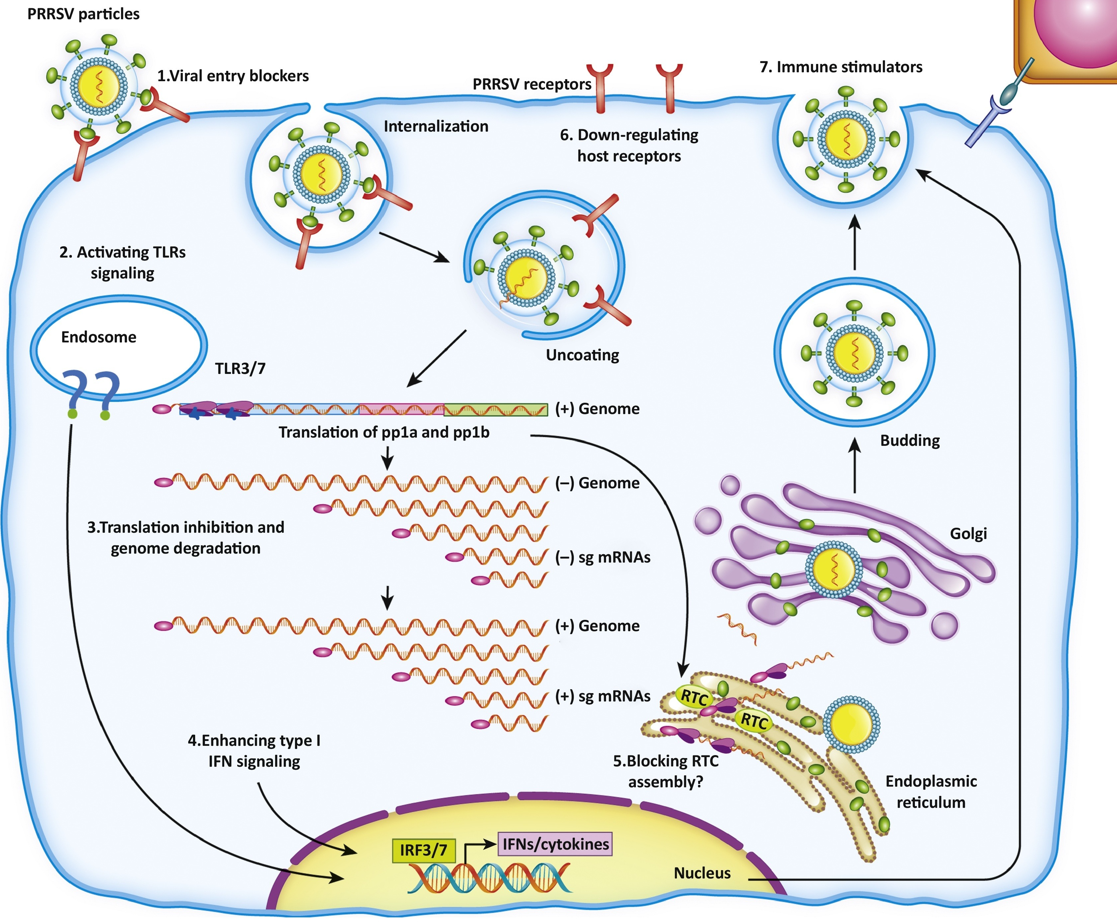猪蓝耳病毒N蛋白
2023.06.12
主要特征是感染猪发热、厌食,妊娠母猪晚期流产、早产、产死胎、弱胎和木乃伊胎,各种年龄猪(特别是仔猪)呼吸障碍等。
PRRSV属于尼多病毒目(Nidovirales)动脉炎病毒科动脉炎病毒属的成员,根据病毒的抗原性,基因组及致病性的差异,PRRSV可分为2个型,即欧洲型(LV株为代表株)和美洲型(ATCC-VR2332株为代表株),两种毒株间氨基酸的同源性为78%~81%。
不同年龄、品种和性别的猪均能感染,但以妊娠母猪和1月龄以内的小猪最易感;PRRSV有严格的宿主专一性,家猪是唯一的宿主。大部分感染了蓝耳病病毒(PRRS)的猪在7-14天左右的范围内发展出抗体。少部分猪(少于5%)会延迟到21天之前发展出抗体。这些最初产生的抗体指向的是蓝耳病毒的N蛋白,N蛋白(nucleocapsid protein)是PRRSV的一种重要结构蛋白,在病毒的包装中起重要作用,是蓝耳病毒抗原性最强的蛋白,但是N蛋白抗体跟保护性没有直接关系,因为它们没有病毒中和能力。大部分的商业ELISA试剂盒使用N蛋白进行诊断,一方面是因为可以实现早期诊断。

The PRRS virus is an enveloped RNA virus in the genus Arterivirus, classified in the virus family, Arteriviridae. There is considerable heterogeneity in the genome of the PRRS virus because of inherent errors common in transcription of RNA. The prototype US virus is related to but distinct from the first European isolate (referred to as Lelystad virus) identified in the Netherlands. There are significant genetic and antigenic differences between these initial isolates. Genetic and antigenic variability between isolates, even within a country, remains a continuous challenge to control of the disease.
PRRS is probably the most important swine disease of the last half-century. Serological testing has revealed there are many infected herds in which signs are not apparent. Where signs are apparent, they vary and are influenced by (1) virulence of the virus, (2) whether it is an initial infection or ongoing (endemic with herd immunity), (3) the age group affected, (4) other disease causing agents present in the population, and (5) herd size and management practices.
Clinical signs and history often suggest PRRS, especially in acute outbreaks. Characteristic microscopic lesions in lungs and several other tissues also are suggestive but not pathognomonic. PRRS infection is widespread in US herds so care must be taken to both confirm an active infection and to rule out other infectious diseases. Any tentative clinical diagnosis should be confirmed by detection of the PRRS virus. This can be by virus isolation (VI), detection of PRRS antigen by fluorescent antibody tests (FAT) or immunohistochemistry (IHC), or detection of PRRS virus genome by polymerase chain reaction (PCR) and be coupled with presence of typical lesions. Serology provides indirect evidence of infection but does not determine if there is actual disease caused by PRRS virus.
There is no single successful strategy for control of PRRS, largely because of virus variation, large swine populations, and unresolved issues of transmission. In some smaller herds, immunity may be sufficient so that infection is not causing significant economic losses, in which case no intervention is necessary. Often, there are sufficient losses to consider some or all of the following points for control. A control program should be tailored to fit the individual farm situation.
An accurate diagnosis is essential to confirm the disease and epidemiology on a particular farm. This requires both disease characterization (demonstrate disease agents and lesions) and a serologic profile of pigs in the various stages of production. Serologic testing of a significant sample of animals from each stage of production should indicate the stage (acute or chronic) of infection in the herd as well where and how the virus is being spread in the herd. Once the disease is defined, a strategy can be developed to achieve one of two general goals, either to eliminate PRRS or to control (“live with”) PRRS.
The goal of many herds is to “stabilize” the infection in the sow herd by assuring immunity in all breeding stock. This “herd immunity” prevents the reproductive failure and can decrease the likelihood of transmission of virus from dams to fetuses and offspring. When coupled with segregated rearing of offspring, clinical effects of infection can be minimized. Breeding herd stabilization can sometimes be accomplished by vaccination, intentional whole-herd infection, aggressive acclimatization of replacement breeding stock, or combinations of these strategies.
我公司重组表达的猪蓝耳N蛋白,货号PSN1-00,纯度高,特异性好,背景低,与市面知名公司IDEXX相关试剂盒的相关性较好, R²>0.9,可以很好的应用于ELISA,POCT等


